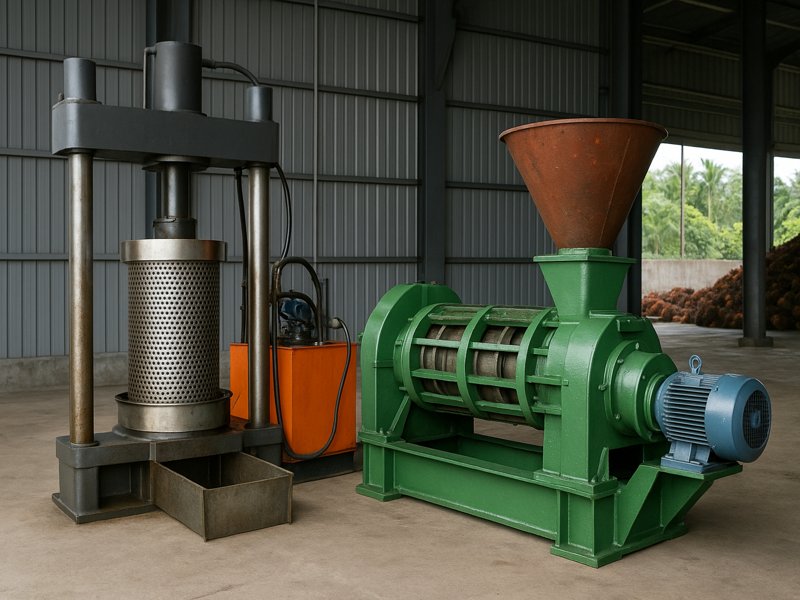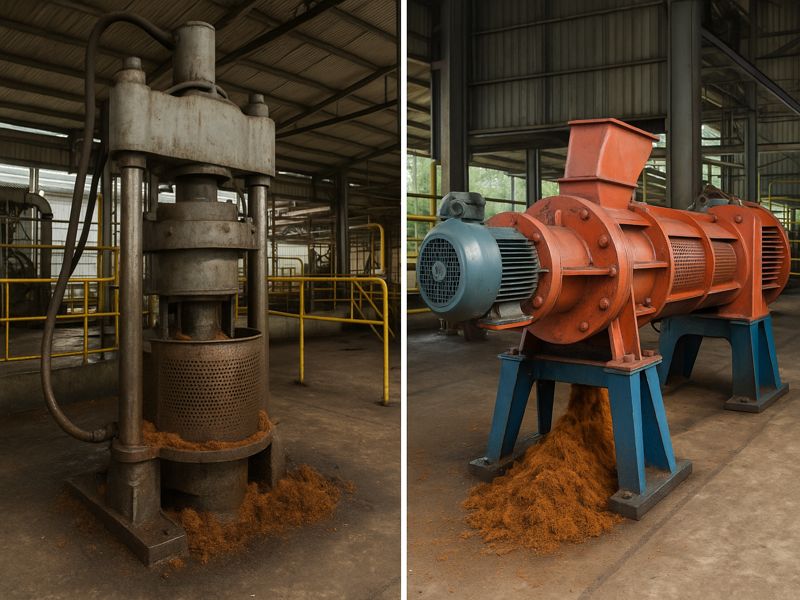Pressing sits at the heart of every palm oil mill. After sterilization and threshing, the digested fruit mash must be pressed to separate crude palm oil (CPO) from fiber and nuts. The choice of press machine—most commonly hydraulic or screw—shapes extraction efficiency, operating cost, product quality, and how easily your mill scales or automates. This guide explains how each press works, where it fits best, and how to choose confidently for new builds or upgrades.
Where the Press Fits in the Line
A typical flow is:
FFB reception → Sterilization (steam) → Threshing → Digestion (heating + mechanical mashing) → Pressing → Clarification & Purification → Storage.
The press must accept hot, well-digested mash (usually ~90–100 °C), create adequate compression to express oil, and discharge a press cake that is dry enough to minimize oil losses but still suitable for downstream kernel recovery.

Hydraulic Presses
How they work
Hydraulic presses apply force intermittently using a hydraulic cylinder acting on a ram. Mash is loaded into a cage or basket (often lined with perforated plates). The ram compresses the mash, oil drains through perforations to a collection channel, and the ram retracts so operators can open the cage and reload for the next cycle. Some mills use multi-ram or carousel arrangements to raise throughput.
Typical configuration
- Batch operation (manual or semi-automatic).
- Simple hydraulics (pump, reservoir, control valves), welded frame, perforated cage, and drain channels.
- Small installed motor power, but cycle-time dependent throughput.
- Best suited to village-scale or artisanal production, pilot plants, or specialty lines.
Strengths
- High unit pressure is possible on a compact footprint.
- Simple mechanics; straightforward to understand and maintain.
- Low acquisition cost for small capacities.
- Flexible—can handle variable feed characteristics without complex controls.
Limitations
- Batch, stop-start workflow limits capacity and raises labor per ton.
- Inconsistent cake dryness and higher residual oil than continuous screw presses in most cases.
- Harder to integrate into fully automated lines; operators handle loading/unloading.
- If cycle times are long, FFA may rise due to warm holding of mash before pressing and more exposure to air.
- Wear and cleaning of perforated baskets can be labor-intensive.
Best fit: micro or cottage mills; R&D; locations with intermittent power; mills valuing low capex more than maximal recovery.
Screw Presses
Screw presses are continuous machines that dominate modern industrial palm oil mills. Two main styles are used:
- Single-Screw Press (worm press)
- Double-Screw (Twin-Screw) Press with intermeshing counter-rotating screws
Core principle
A rotating screw (or screws) conveys hot mash through a cylindrical cage with drainage slots or bars. The flight geometry, pitch reduction, and barrel clearance progressively compress the mash. Oil drains through the cage; solids exit as a compact press cake. Proper digestion and feed temperature are critical to reduce torque spikes and improve oil release.
Single-Screw Press
- One rotating worm shaft inside a slotted cage.
- Throughput commonly 5–10 t FFB/h per unit (smaller/larger variants exist).
- Mechanical simplicity, wide parts availability, proven in thousands of mills.
Pros: economical, simpler maintenance, modular capacity (add more units), good integration with conveyors/PLCs.
Trade-offs: slightly higher residual oil vs. a well-tuned twin-screw; more torque concentration along one shaft demands a robust gearbox and periodic hardfacing of flights and cage bars.
Double-Screw (Twin-Screw) Press
- Two intermeshing, counter-rotating screws; mash is compressed between the screws and against the cage.
- Per-unit capacity often 10–25+ t FFB/h.
- More uniform shear/compression, typically drier press cake (lower residual oil).
Pros: high throughput, higher oil recovery (lower residuals), stable operation at large scales, favorable cake dryness for kernel recovery.
Trade-offs: higher capex, more complex mechanics (two shafts, gear train), higher installed power, skilled maintenance required.
Side-by-Side Comparison
Operating mode, yield, energy, and maintenance
| Factor | Hydraulic Press | Single-Screw Press | Double-Screw Press |
| Operation | Batch (intermittent) | Continuous | Continuous |
| Typical Unit Capacity | 0.3–3 t/h (batch-dependent) | 5–10 t/h | 10–25+ t/h |
| Extraction / Residual Oil | Variable; generally higher residuals | Good-tuned units perform well | Best, typically lowest residual |
| Cake Dryness | Variable; depends on cycle control | Good | Very good |
| Energy (Installed Power) | Low per unit energy/ton varies with cycle | ~20–50 kW per unit | ~60–100+ kW per unit |
| Labor Requirement | Higher (loading/unloading) | Moderate | Moderate |
| Maintenance | Hydraulics + cage cleaning | Wear on worm flights, cage bars, and bearings | More parts: two screws, gears, bearings |
| Automation | Limited; semi-auto possible | Easy to integrate with PLC/SCADA | Easy to integrate; complex interlocks |
| Capex | Low (small scale) | Moderate | Highest |
| Best Use Case | Village/pilot | Small–medium mills | Medium–large mills |
Note: Actual capacities and kW ratings depend on fruit quality, digestion, screw geometry, cage gap, and line design.
Quality Impacts: Oil, Nuts, and Clarification
Oil Quality (FFA, impurities):
Continuous presses shorten exposure of hot mash to air vs. batch queues, helping limit FFA rise. Proper screening and dilution after pressing still determine the clarification load. In general, screw presses (especially twin-screw) deliver more consistent oil flow with fewer big slugs of fines than manual hydraulic cycles.
Press Cake & Kernel Recovery:
Drier cake improves nut–fiber separation and kernel recovery efficiency. Twin-screw presses usually give the driest cake, aiding downstream depericarper and nut crackers.
Wear Metals & Contamination:
Flight/cage wear can shed particles. Specify hardfaced, food-contact-appropriate materials, maintain bar gaps, and implement magnetic traps or strainers before clarification.
Energy & Throughput
- Hydraulic presses often show low installed motor power, but the intermittent duty and longer warm dwell times can increase energy per ton (stop-start losses, longer heating).
- Single-screw units (approx. 20–50 kW each) suit modular lines; you can parallelize presses to match sterilizer capacity.
- Twin-screw units (approx. 60–100+ kW) deliver more tons per unit, frequently lowering energy per ton at high throughput despite higher nameplate kW.
Spares and Reliability
Hydraulic Press
- Critical spares: cylinder seals, pumps, valves, pressure gauges, cage liners.
- Failure modes: seal leakage, pressure loss, frame alignment drift.
- PM tasks: oil cleanliness checks, seal inspection, bolt torque verification, safety relief tests.
Screw Press
- Critical spares: worms (several stages), cage bars, press cone, bearings, shaft sleeves, gearbox internals, V-belts/couplings.
- Failure modes: excessive wear → rising power draw and oil loss; cracked bars; cone seizure.
- PM tasks: daily cleaning of slots, weekly cone checks, scheduled worm/bar replacement, gearbox oil analysis.
In both cases, operator charts (torque, temperature, yield, cake moisture) help detect drift early.
Maintenance Considerations
Hydraulic presses:
Keep seals, hoses, and pumps in good condition; prevent oil leaks; clean perforations to maintain drainage. Cycle timers affect consistency.
Single-screw:
Expect periodic hardfacing of screw flights, replacement of cage bars/liners, attention to gearbox lubrication and temperature, and shaft bearing checks. Maintain feed temperature from the digester to avoid torque spikes.
Twin-screw:
All the above, plus synchronization of two screws, gear train alignment, and balanced wear management between screws. Spare parts planning is critical.
Choosing by Mill Size and Strategy
| Mill Type (FFB throughput) | Recommended Press Type | Rationale |
| Micro (<5 t/h) | Hydraulic or Single-Screw (small) | Low capex; simple operation; single-screw if you want continuous flow. |
| Small (5–10 t/h) | Single-Screw | Proven, economical, easy to maintain, and scalable with parallel units. |
| Medium (10–25 t/h) | Single-Screw or Twin-Screw | Choose twin-screw for higher recovery and drier cake; single-screw if capex is tighter. |
| Large (25+ t/h) | Twin-Screw | High capacity per unit, lower residual oil, strong platform for full automation. |
Cost & Lifecycle View
- Capex: Hydraulic (lowest for micro scale) < Single-screw < Twin-screw (highest).
- Opex: Twin-screw often wins at large scale on oil recovery (less oil lost in cake), labor, and energy/ton, offsetting its higher purchase price.
- Spares & Availability: Single-screw parts are widely available across markets; twin-screw parts may require OEM channels and planned lead times.
- Downtime Impact: A single large twin-screw down event can halt a big line; many mills mitigate risk with N+1 redundancy or one smaller auxiliary press.
Integration & Automation
- Feeding: Screw presses pair well with screw conveyors or pumps from digesters. Maintain mash temperature (≈90–100 °C) and homogeneity.
- Control: Variable frequency drives (VFDs) on press motors enable torque management and throughput tuning. PLC integration monitors motor load, temperature, vibration, and oil flow to warn about wear or choking.
- Safety: Interlocks on hopper covers, cage doors, and torque overloads are essential. Provide guarded rotating parts and lockout/tagout procedures.
- Sanitation: Hot washdowns and scheduled cleaning cycles prevent gum/solids buildup in drainage slots.
Practical Pros & Cons at a Glance
Hydraulic Press
- Lowest capex for tiny mills; simple mechanics; tolerant to feed variability
- Batch labor, slower cycles, inconsistent cake dryness, typically higher oil losses, harder to automate end-to-end
Single-Screw Press
- Continuous, proven, widely supported, modular scaling, good balance of cost and performance
- More oil loss than a well-tuned twin-screw; requires regular hardfacing and bar maintenance
Twin-Screw Press
- Highest throughput per unit, best cake dryness, lowest residual oil, ideal for automation and kernel recovery efficiency
- Highest capex and complexity; needs skilled maintenance and planned spares
Installation Tips for Best Results
Digest well, press easily: Invest in effective digestion (correct residence time, temperature, and mechanical action). Poor digestion punishes any press with higher torque and lower recovery.
Keep it hot: Maintain mash at ~90–100 °C until pressing; insulate chutes and minimize hold-ups to avoid FFA rise.
Manage solids: Fit proper screens/strainers under the press to reduce fiber carry-over into the clarification plant.
Track wear and torque: Trend motor current/torque and oil flow. Rising torque with falling oil flow often flags cage fouling or flight wear.
Plan spares: Keep critical spares—worm flights, cage bars/liners, bearings, seals, hydraulic hoses, and gear oils—on site.
Calibrate cake dryness: Periodically sample cake for residual oil and moisture; adjust cage bar gaps and speed to optimize recovery without choking.
Safety first: Guard all rotating components; employ interlocks and emergency stops near feed hoppers and discharge points.
or very small operations. Single-screw presses provide a versatile, continuous backbone for small to medium mills with accessible spares and modular scaling. Twin-screw presses unlock high capacity, low residual oil, and dry cake, making them the preferred choice for medium to large mills pushing for efficiency and full automation.
If you’re designing or upgrading a mill, start with your production targets and digester performance, and make your selection based on labor patterns, maintenance capabilities, and energy strategies. In most commercial scenarios, this process ultimately leads to a screw press, combined with thoughtful redundancy and an active spare parts program to ensure consistently high overall equipment effectiveness (OEE) and production output.


